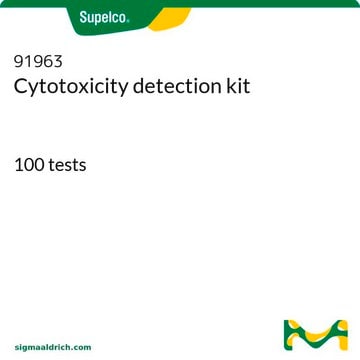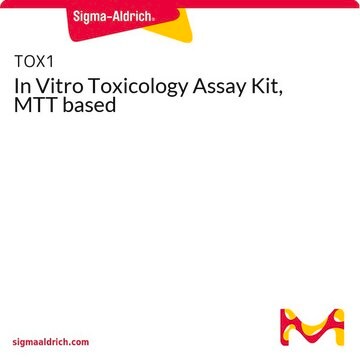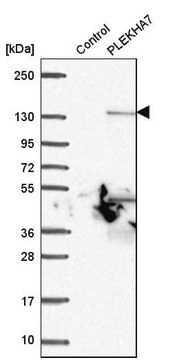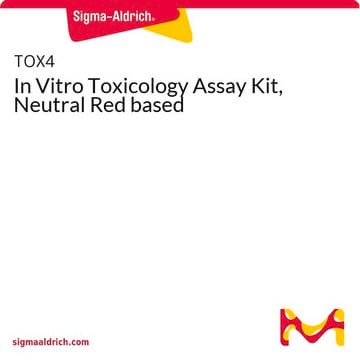CYTODET-RO
Roche
Cytotoxicity Detection KitPLUS (LDH)
sufficient for 400 multiwell tests (04744926001), sufficient for 2,000 multiwell tests (04744934001), kit of 1 (4 components), suitable for protein quantification, suitable for cell analysis, detection
About This Item
Polecane produkty
Postać
liquid
Poziom jakości
zastosowanie
sufficient for 2,000 multiwell tests (04744934001)
sufficient for 400 multiwell tests (04744926001)
opakowanie
kit of 1 (4 components)
producent / nazwa handlowa
Roche
warunki przechowywania
avoid repeated freeze/thaw cycles
metody
protein quantification: suitable
λmaks.
490-492 nm
Zastosowanie
cell analysis
detection
metoda wykrywania
colorimetric
temp. przechowywania
−20°C
Opis ogólny
Zastosowanie
- The Cytotoxicity Detection KitPLUS (LDH) is a fast, sensitive, and simple method to quantify cytotoxicity/cytolysis based on the measurement of LDH activity released from damaged cells using the 96-well or 384-well plate format. The kit can be used in many different in vitro cell systems when damage to the plasma membrane occurs. For example: Detection and quantification of cell-mediated cytotoxicity.
- Determination of mediator-induced cytolysis.
- Determination of the cytotoxic potential of compounds in environmental and medical research, and in the food, cosmetic, and pharmaceutical industries.
- Determination of cell death in bioreactors.
Cechy i korzyści
- Flexible, since the assay can determine the degree of plasma membrane damage in many different in vitro cell systems.
- Safe, because the assay does not use radioactive isotopes.
- Accurate, since assay results strongly correlate to the number of lysed cells.
- Sensitive, since the assay can detect even low cell numbers.
- Fast, since assay results can be determined on a multi-well ELISA reader, which allows simultaneous processing of many samples.
- Convenient, since the assay does not require a prelabeling step.
Opakowanie
- 04744926001 (1 kit containing 4 components)
- 04744934001 (1 kit containing 4 components)
Uwaga dotycząca przygotowania
Dissolve the lyophilizate in 1 ml double dist. water for 10 min, then mix thoroughly.
Reaction mixture:
For 100 tests: Shortly before use, mix 250 μl of reconstituted catalyst with 11.25 ml dye solution
For 400 tests: Shortly before use, add the total volume of reconstituted catalyst (1 ml) to the total volume of dye solution (45 ml) and mix well.
Note: In case you observe crystals in “Dye solution”, shake the bottle at least 1 hour at 37 °C. Remaining precipitates will NOT influence the performance.
Note: The precipitates were formed during the freezing of the product. Repeated freezing and thawing should be avoided.
Note: Prepare immediately before use. Do not store the Reaction mixture.
Storage conditions (working solution): The lyophilizate is stable at 2 to 8 °C.
The reconstituted catalyst solution, the dye solution the lysis solution and the stop solution are stable for
- Four weeks when stored at 2 to 8 °C
- Two days at 15 to 25 °C
- For long-term storage (up to 3 months), store bottles at -15 to -25 °C.
- Freezing and thawing the solutions up to three times will not significantly reduce their performance. When crystals are seen in Dye solution, shake the bottle at least one hour at 37 °C. Remaining precipitates will not influence performance. As the precipitates can be formed during freezing of the product, repeated freezing and thawing should be avoided.
Inne uwagi
Tylko elementy zestawu
- Catalyst (Diaphorase/NAD+ mixture)
- Dye Solution (INT and sodium lactate)
- Lysis Solution
- Stop Solution
produkt powiązany
Hasło ostrzegawcze
Danger
Zwroty wskazujące rodzaj zagrożenia
Zwroty wskazujące środki ostrożności
Klasyfikacja zagrożeń
Aquatic Chronic 3 - Eye Dam. 1 - Met. Corr. 1
Kod klasy składowania
8B - Non-combustible, corrosive hazardous materials
Klasa zagrożenia wodnego (WGK)
WGK 2
Temperatura zapłonu (°F)
does not flash
Temperatura zapłonu (°C)
does not flash
Certyfikaty analizy (CoA)
Poszukaj Certyfikaty analizy (CoA), wpisując numer partii/serii produktów. Numery serii i partii można znaleźć na etykiecie produktu po słowach „seria” lub „partia”.
Masz już ten produkt?
Dokumenty związane z niedawno zakupionymi produktami zostały zamieszczone w Bibliotece dokumentów.
Klienci oglądali również te produkty
Produkty
Quality control guidelines to maintain high quality authenticated and contamination-free cell cultures. Free ECACC handbook download.
Nasz zespół naukowców ma doświadczenie we wszystkich obszarach badań, w tym w naukach przyrodniczych, materiałoznawstwie, syntezie chemicznej, chromatografii, analityce i wielu innych dziedzinach.
Skontaktuj się z zespołem ds. pomocy technicznej










